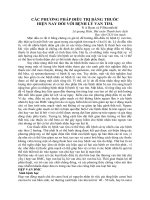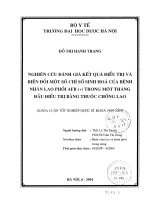điều trị bằng thuốc insulin
Bạn đang xem bản rút gọn của tài liệu. Xem và tải ngay bản đầy đủ của tài liệu tại đây (253.22 KB, 41 trang )
Slides current until 2008
Điều trị bằng thuốc
Insulin
Section 3 | Part 2 of 3
Curriculum Module III-3 | Insulin
Slides current until 2008
Insulin Management
Curriculum Module III-3
Slide 2 of 41
Insulin
•
Một hóc-môn được tế bào beta tuỵ bài tiết
•
Được bài tiết để đáp ứng với tăng glucose hoặc
các kích thích khác, ví dụ amino acids
•
Đáp ứng bình thường có đặc điểm insulin nền
thấp, tăng vọt lên khi có tăng đường máu
Slides current until 2008
Insulin Management
Curriculum Module III-3
Slide 3 of 41
Tác dụng của Insulin
1. Tăng thu nhập glucose, đặc biệt ở cơ, gan và mômỡ
2. Giảm lượng glucose từ gan
3. Tăng tạo mỡ
4. ức chế phân huỷ mỡ
5. Tăng thu nhập amino-acid và ngăn phân huỷ protein
Slides current until 2008
Insulin Management
Curriculum Module III-3
Slide 4 of 41
Chỉ định điều trị insulin
•
ĐTĐ týp 1
•
Phụ nữ bị ĐTĐ có thai hoặc cho con bú
•
Bệnh nhân ĐTĐ típ 2 trong một số tình trạng đặc
biệt
•
Trong ĐTĐ typ 2, kiểm soát thuốc viên hạ đường
huyết không tốt (thất bại thứ phát)
Slides current until 2008
Insulin Management
Curriculum Module III-3
Slide 5 of 41
Insulin trị liệu
•
Nhằm bắt chước đáp ứng insulin sinh lý bình thường
•
Phác đồ điều trị nên được cá nhân hoá tuỳ theo
•
Thể bệnh ĐTĐ
•
Chấp nhận tiêm
•
Lối sống
•
Theo dõi đường máu
•
tuổi
•
sự khéo tay
•
Mục tiêu đường máu
Slides current until 2008
Insulin Management
Curriculum Module III-3
Slide 6 of 41
Các loại Insulin và tác dụng
Bắt đầu (hrs) Đỉnh (hrs) Kéo dài (hrs)
Nhanh
lispro
aspart
<¼ ¾-2½ 3½-4½
Ngắn
soluble
regular
½-1 2-4 6-8
Trung gian
NPH
Lente
1-2
1-3
6-12
6-12
18-24
18-24
Kéo dài
ultralente glargine
detemir
4-6
3-4
1-2
8-20
3-24
3-8
24 or more
≥24 or more
12-24 (dose-
dependent)
Slides current until 2008
Insulin Management
Curriculum Module III-3
Slide 7 of 41
Nhãn mác quốc tế
www.idf.org
Slides current until 2008
Insulin Management
Curriculum Module III-3
Slide 8 of 41
Sự đa dạng về khả năng hấp thụ insulin
Slides current until 2008
Insulin Management
Curriculum Module III-3
Slide 9 of 41
Các yếu tố ảnh hưởng đến sự hấp thụ
•
Phì đại mỡ
•
Liều tiêm
•
Vị trí và độ sâu mũi tiêm
•
Luyện tập
•
Nhiệt độ cơ thể và môi trường
•
Loại insulin
•
Incomplete re-suspension
Slides current until 2008
Insulin Management
Curriculum Module III-3
Slide 10 of 41
•
Phác đồ insulin thường dùng nhất ở nước bạn là gì?
•
Theo bạn, nó tác dụng tốt đến đâu?
•
Mọi người chấp nhận insulin như thế nào?
Bài tập
Slides current until 2008
Insulin Management
Curriculum Module III-3
Slide 11 of 41
Các phác đồ Insulin: 1 mũi /ngày
Soluble insulin
Intermediate-
acting insulin
Slides current until 2008
Insulin Management
Curriculum Module III-3
Slide 12 of 41
Hai mũi insulin/ngày
Soluble insulin
Intermediate-
acting insulin
Slides current until 2008
Insulin Management
Curriculum Module III-3
Slide 13 of 41
Ba mũi insulin/ngày
Soluble insulin
Intermediate-
acting insulin
Slides current until 2008
Insulin Management
Curriculum Module III-3
Slide 14 of 41
Rapid acting insulin
analogue
Intermediate-
acting insulin
Mũi nền liều lớn
Slides current until 2008
Insulin Management
Curriculum Module III-3
Slide 15 of 41
Long acting insulin
analogue
insulin bán tổng hợp tác dụng kéo dài
Rapid acting insulin
analogue
Slides current until 2008
Insulin Management
Curriculum Module III-3
Slide 16 of 41
Bắt đầu điều trị insulin
•
Insulin should never be used as a threat
•
Fear of injecting is common; needle phobia is rare
•
Healthcare professional’s attitude is key to acceptance
•
People should be praised and encouraged to promote a
positive attitude
•
Blood test is more painful than insulin injection
•
Forget the oranges; just do it!
Slides current until 2008
Insulin Management
Curriculum Module III-3
Slide 17 of 41
Commencing insulin therapy
•
Starting dose will depend on many factors
–
Age
–
Weight
–
Type and duration of diabetes
–
Glycaemic targets
•
In type 2 diabetes, consider continuing maximum
tolerated oral glucose lowering medication
–
10 units of intermediate acting insulin once a day
Slides current until 2008
Insulin Management
Curriculum Module III-3
Slide 18 of 41
Injecting insulin
•
Should be given into subcutaneous tissue
•
Skin of a very thin person may have to be gently
pinched
•
Insulin at room temperature less painful
•
Needle can be inserted at 45-90
º
–
45
º
for very thin people
–
90
º
for overweight people or when using short needle
•
Swabbing with alcohol is not necessary
Slides current until 2008
Insulin Management
Curriculum Module III-3
Slide 19 of 41
Insulin devices
Syringe and needle
•
Usually disposable, intended for one
injection only
•
May need to use doses divisible by 5 or
10 if visually impaired
Pens
•
Easy to use
•
Loading pen may be difficult for
elderly
•
Disposable pens
Slides current until 2008
Insulin Management
Curriculum Module III-3
Slide 20 of 41
Insulin devices
Pumps
•
Insulin delivered every few minutes over 24 hours
•
Require large commitment
Inhaled Insulin
•
For bolus doses only
•
Large device
•
?? Long term effects on lungs
Slides current until 2008
Insulin Management
Curriculum Module III-3
Slide 21 of 41
HbA
1C
Pre-meal 2 hours post-
meal
Target for most
people with diabetes
<7% 4-7mmol/L
*
90-130mg/dl
*1
5-10mmol/L
*
<180mg/dl
*1
IDF Global
guideline for Type 2
diabetes
*2
<6.5% <6.0mmol/L
<110mg/dl
<8.0mmol/L
<145mg/dl
Adjusting insulin – What are the
targets?
*
CDA 2003,
*1
ADA 2004,
*2
IDF 2005
•
Treatment targets should be individualised, especially
for very young and very old
•
Absence of hypoglycaemia
Slides current until 2008
Insulin Management
Curriculum Module III-3
Slide 22 of 41
Starting insulin in type 2
FINFAT: Start small dose intermediate acting insulin at
night
•
Aim for target fasting levels first
•
Adjust by 2-4 units or 10%
•
Second injection only added once fasting targets
reached
Slides current until 2008
Insulin Management
Curriculum Module III-3
Slide 23 of 41
Adjusting insulin
Pattern management
•
Watch levels for 2-3 days
•
Address hypoglycaemia first
•
Aim for target fasting levels next
•
Adjust by 2-4 units or 10%
•
Wait 2-3 days
Slides current until 2008
Insulin Management
Curriculum Module III-3
Slide 24 of 41
Adjusting Insulin
•
Flexible dose guideline
•
Eating more
•
Exercising more
•
Insulin to carbohydrate ratio
•
Evaluate with next blood glucose
•
Tailored to individual needs
Slides current until 2008
Insulin Management
Curriculum Module III-3
Slide 25 of 41
Which insulin to adjust when?
Blood glucose Insulin to be changed
Fasting Bedtime or supper intermediate- or long-acting
Post-breakfast Morning short or rapid acting insulin
Pre- lunch Morning intermediate acting insulin
Post-lunch Morning intermediate acting insulin or lunchtime
short or rapid acting insulin
Pre-supper (dinner) Morning intermediate acting insulin
Post-supper (dinner) Supper-time short- or rapid-acting insulin
During the night Supper-time or bedtime intermediate-acting









